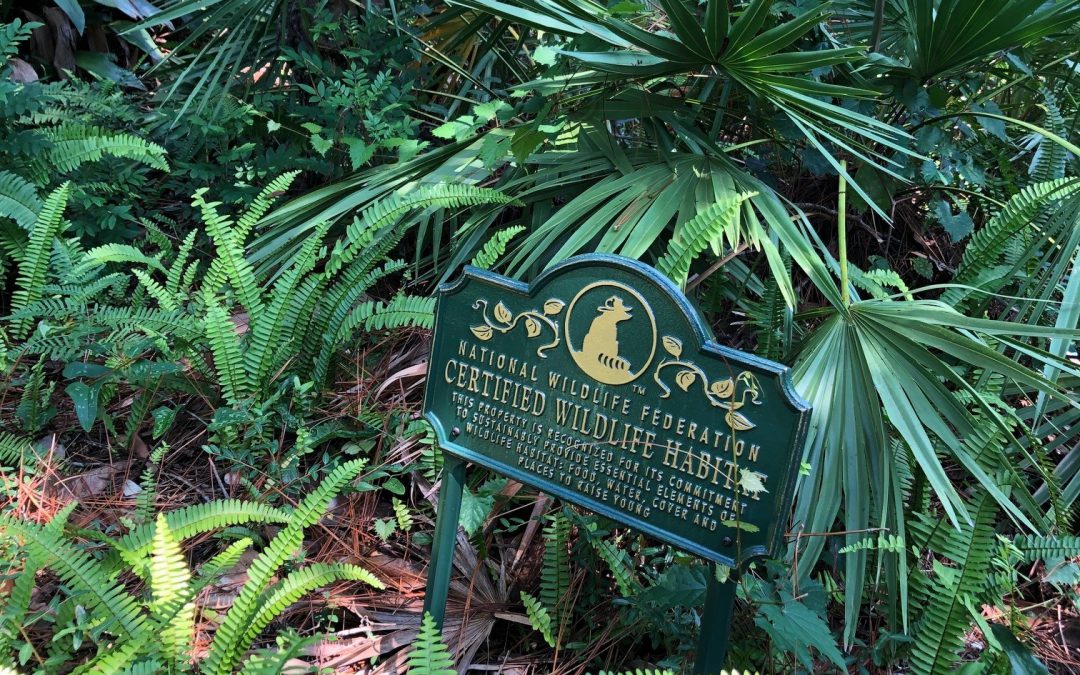
by Carrie Stevenson | Sep 17, 2021
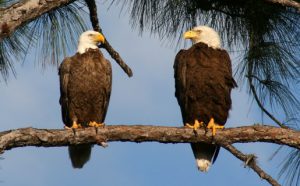
Bald eagles and other large birds of prey have made a comeback in Florida.
Florida has all the elements of a wild animal’s paradise. The state has abundant rain and water sources, lush vegetation, plenty of food, and tons of nesting and hiding places. In our state and national parks, conservation easements, open waters, and acres of ranch land, large populations of animals can thrive. Particularly in areas with fewer people, healthy populations of even large animals like black bears, alligators, and panthers can maintain substantial territories. However, human migration into and throughout Florida is increasing at as steady a rate as ever. Retirees have long fled their cold northern winters to move part or full time to Florida. Now, the ability for many working people to telecommute from anywhere has made it attractive for younger families from all over the country to join us.
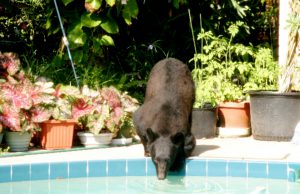
A black bear helps himself to a drink from the swimming pool of a Florida home. Photo provided by Patty Underwood/FWC
With more people comes the need for more housing. Some are content with high rise condos that leave a smaller footprint, but these are often located right on the water and can displace coastal wildlife and vegetation. For the thousands of families moving in weekly, more subdivisions, roads, stores, and schools are necessary. Inevitably, these lead to human-wildlife interactions that may or may not be positive experiences. In fast-growing south Santa Rosa County, I see almost daily reports of large black bears in backyards and trash cans. For smaller mammals, the threat of being hit by a car is unfortunately very common. For nearly every call we get about an exciting manatee sighting, we get word of a nerve-wracking interaction with a snake. As civilization moves closer to forested, once-wild areas, wildlife can be squeezed out, left without the protection of natural cover and drawn to human food and habitat.
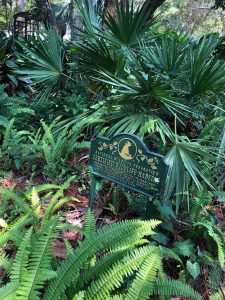
A lush backyard landscape surrounds a recognition sign from the National Wildlife Federation. Photo credit: Carrie Stevenson, UF IFAS Extension
There are plenty of ways we can co-exist, though. A Florida-friendly yard is a wildlife-friendly yard, and those who go the extra mile can even be recognized by the National Wildlife Federation for their efforts. There are several steps one needs to take to become wildlife-friendly. The most important include providing food, water, and cover, so the animals’ basic needs are met. Actions like removing invasive species, keeping pets supervised when outdoors, and adding layers of vegetation are also excellent ways to attract and protect native creatures.
While small and medium sized animals can find shelter in a single yard, it takes neighborhood cooperation to be a haven for something larger, like deer, bears, birds of prey, or large tortoises. Some neighborhoods are designated from the beginning to include conservation easements that serve as amenities to the neighborhood. They include trails, shady waterfront areas, and plenty of space for wildlife. It is important when moving into one of these neighborhoods that each homebuyer understands and respects the purpose behind conservation areas. Residents of older, existing neighborhoods can also work together to designate common areas and stretches of adjoining yards as wildlife-friendly corridors, allowing more animals to use the space safely.
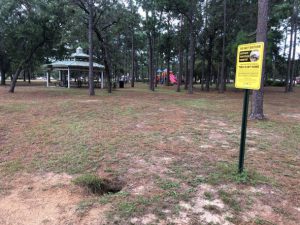
A gopher tortoise burrow is noted by a sign in a local city park. The tortoise is co-existing peacefully with its neighbors! Photo credit: Carrie Stevenson, UF IFAS Extension
In my own neighborhood in the city limits, a gopher tortoise has moved in and become a neighborhood mascot of sorts! When alerted to the presence of its burrow, the city brought in a sign explaining the animal’s protected status and crucial role in the environment. Floridians share their citizenship with thousands of other species. These breathtaking birds, fish, mammals, reptiles, and insects are integral to the health of our land and water. By taking steps to look out for their well-being, we are also providing for our own.
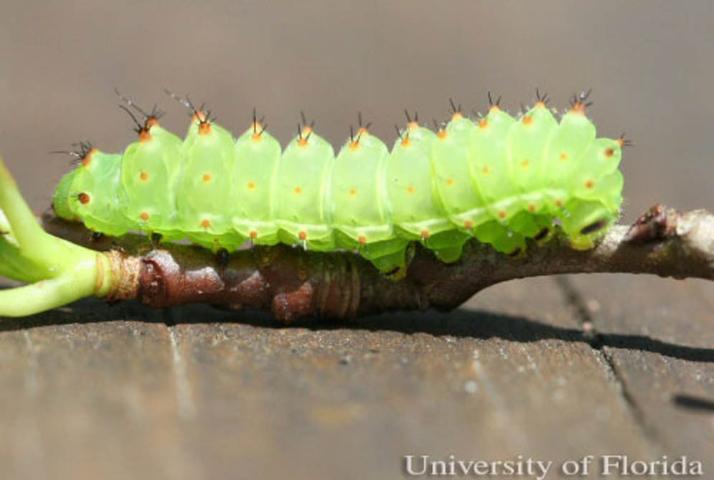
by Carrie Stevenson | Aug 5, 2021
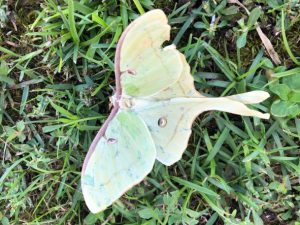
The moon-like eyespots and long tails on its wings are identifying features of the luna moth. Photo credit: Carrie Stevenson, UF IFAS Extension
We hear about butterflies all the time–their beautiful wing patterns, how to plant entire gardens for them, and the fascinating migration patterns of monarchs. But if you look around, you might just find their night-dwelling cousins, the moths, have some pretty incredible traits, too.
I find luna moths (Actias luna) just as interesting as many of the colorful butterflies native to our area. Luna moths are considerably larger than the little brown and black moths you see fluttering around streetlights. Their wingspan can be up to 4” wide, with long, tapering tails trailing behind them. The moth is native to the entire eastern portion of the United States, but has a longer life span the further south it resides. Luna moths live year-round in Florida, with up to three generations (trivoltine) born annually. They are pale green, and adults have a furry white underbelly. Lunas are so eye-catching that they have been featured on the cover of a field guide to moths, postage stamps from the United States and other countries, and as the mascot of the insomnia medication, Lunesta.
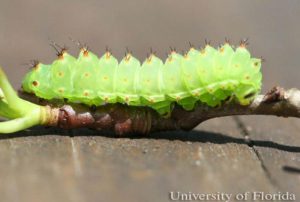
The caterpillar of the luna moth is bright green and warns off predators by making an intimidating clicking sound. Photo credit: University of Florida
Luna moths have several celestial ties in their name. All the moths in its larger family, Saturnidae, have round eyespots (which fool would-be predators) composed of concentric circles like the rings of Saturn. “Luna” comes from the Latin for moon, after the moon-colored eyespots on its back.
Luna moth caterpillars are fat and green—the classic caterpillar—and about 2.5” long. Their preferred host plants in the south are typically sweet gum, hickory, walnut, and persimmon trees. Interestingly, the caterpillars can make a sound, typically described as a clicking noise. Biologists believe this noise-making is a defense mechanism, performed as a precursor to spitting up unpleasant fluids to fend off predators. Several studies have shown that the twisting motion of the adult luna moth’s long tails in flight can interrupt the echolocation of bats, helping the moths evade predation.
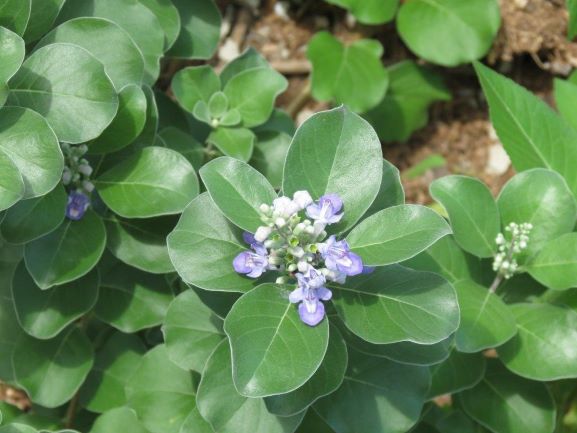
by Carrie Stevenson | May 27, 2021
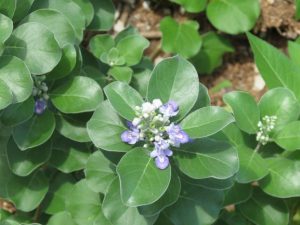
Beach vitex in bloom is an attractive plant, which can make it more difficult to convince property owners of its harmful potential. Photo credit: Rick O’Connor, Florida Sea Grant
One of the biggest problems with beach vitex (Vitex rotundifolia) is its beauty. It has rounded, deep green leaves (with a silvery gray cast) and a beautiful little lavender-purple bloom. Like most weedy invasive plants, the plant was imported and sold as an ornamental groundcover for many years. Homeowners and landscapers planted it in coastal areas where it is well adapted to the salt and heat, and no one realized it would be so problematic. Ever since, beach vitex took root and has continued growing, unchecked, throughout the coastal south.
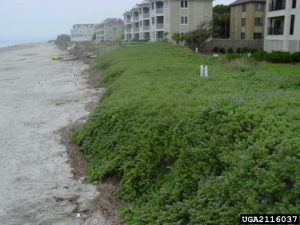
In this photo, beach vitex has overrun all native dune vegetation to form a monoculture. Photo credit: Randy Westbrook, Invasive Plant Control, Inc. bugwood.org
North and South Carolina started having big issues first, when beach vitex was planted deliberately to stabilize sand dunes after hurricanes. Soon after, a coastal restoration specialist with the Army Corps of Engineers realized the mistake. The vines run along the ground in such thick mats that native vegetation like sea oats can be choked out. The wide-spreading fibrous roots and tall profile of sea oats hold sand in place better than the beach vitex’s low growth and taproot, which have long term consequences for maintaining dune stability. The thick tangle of vitex growth is yet another obstacle for hatchling sea turtles in a long list of man-made problems that has made nesting and reproduction difficult.
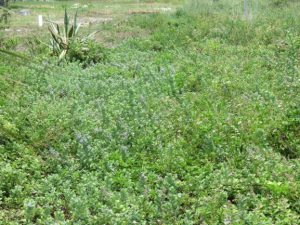
The invasive vine beach vitex has taken over a stretch of sand on Pensacola Beach. Photo credit: Rick O’Connor, Florida Sea Grant
Eradication of the noxious weed has proved difficult. When a plant gets the nickname, “beach kudzu,” you know something went seriously wrong. Beach vitex produces millions of seeds in late summer and early fall, which are dispersed by wind, birds, and float over water. Unless removed before going to seed, even a small patch of the vine can expand rapidly. While not as prevalent in Florida, over 80 sites have been identified in the western panhandle with beach vitex. Due to these problematic issues, the plant was recently added to the Florida Noxious Weed and Invasive Species List, making it illegal to sell, grow, move, or release the plant.
To learn more about how to identify, report, and remove beach vitex, visit www.eddmaps.org or contact Rick O’Connor at roc1@ufl.edu.
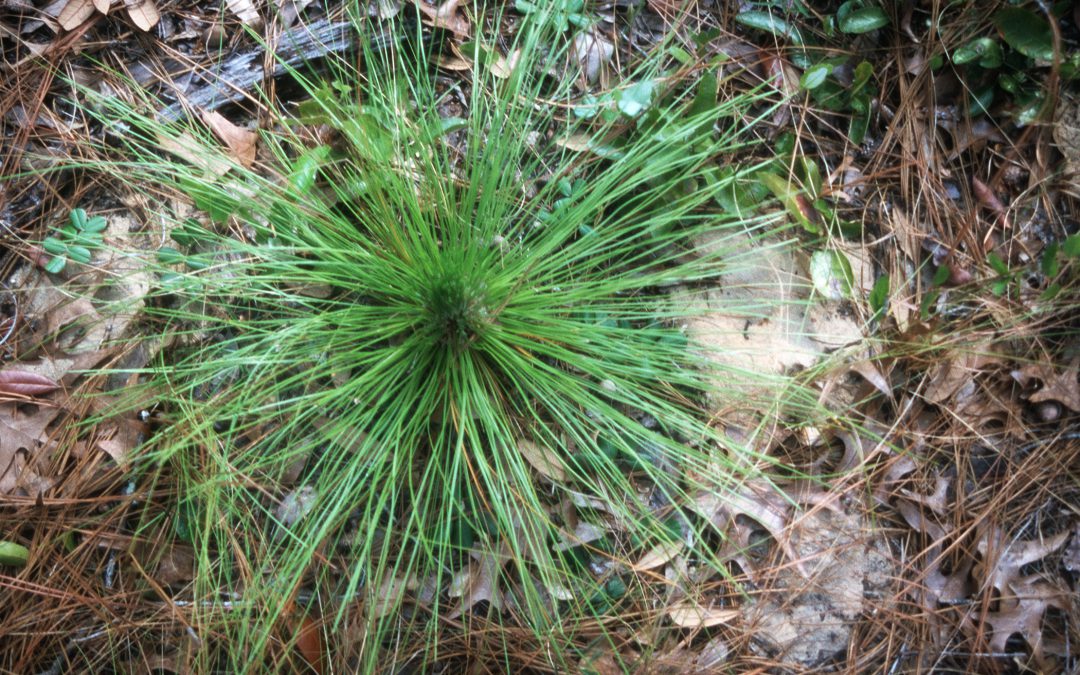
by Carrie Stevenson | Apr 15, 2021
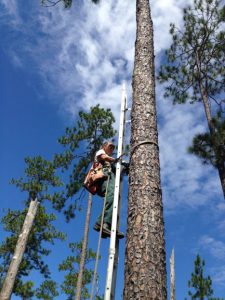
A biologist with Blackwater State Forest checks longleaf pines for signs of red cockaded woodpecker nests. Photo credit: Carrie Stevenson, UF IFAS Extension
Longleaf pine is a granddaddy among the trees of the Southeastern United States, once covering up to 90 million acres throughout the coastal plain. Tall and stately, slow-growing and dense, it was one of the most desirable trees in the forestry and shipbuilding industry for two centuries. Its sap was used to produce turpentine, tar, and pitch, especially to coat and waterproof the bottoms of wooden ships. Its tall, upright form made for a perfect ship’s mast. Between the years 1830 and 1935, approximately 90% of the Southeast’s old growth longleaf trees were harvested, and much of the land was used for farming or development.
Besides its commercial uses, the longleaf ecosystem supports a wide diversity of other plants and animals. The endangered red-cockaded woodpecker nests only in the wood of old (100-500 years!) longleaf pines, and the canopy shades a grassy groundcover often dominated by wiregrass. Gopher tortoises, the endangered indigo snake, and quail also thrive in longleaf pine ecosystems.
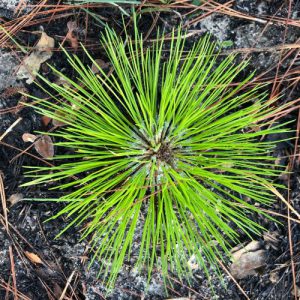
A longleaf pine in its grass stage. Photo credit: Carrie Stevenson, UF IFAS Extension
The longleaf pine is highly adapted to fire while in its “grass” stage and as an older tree, allowing it to tower over smaller hardwoods that are cleared out in natural and prescribed fires. This clearing allows its own seeds to sprout and thrive, and for low-growing grasses to dominate the understory. Pines can be difficult to differentiate in the southern forest, but longleaf pines have deep (up to 8-12 feet) taproots and long needles—up to 18 inches—in fascicles of two or three. The needles grow in spherical bunches that look like cheerleading pom poms.
As ecologists and foresters have realized the important role these trees play in the landscape, significant efforts have been undertaken to restore much of that habitat on both public and private land. Locally, Blackwater State Forest and neighboring Eglin Air Force Base have replanted and managed thousands of acres of longleaf habitat. Foresters and nonprofits also work with private landowners to reestablish these stately pines.
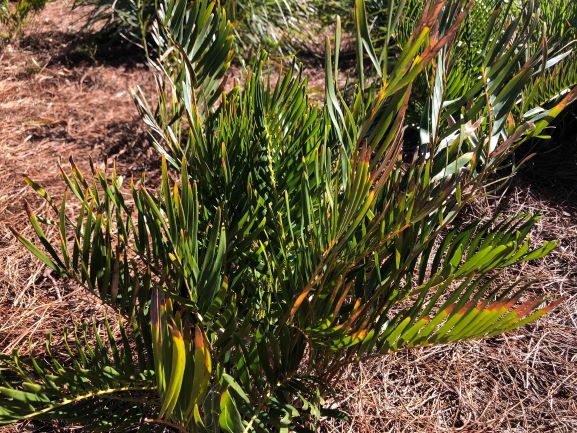
by Carrie Stevenson | Mar 11, 2021
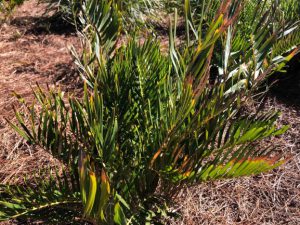
The ancient cycad, coontie, is a hardy and attractive plant for Florida landscapes. Photo credit: Carrie Stevenson, UF IFAS Extension
The plant has a crazy-sounding name, more like some little animal you’d find in Australia than a native plant. However, an ancient Florida plant it is, and a tough one at that. Growing close to the ground, it most resembles a large fern or a sago palm, if the sago had smooth, rounded leaf edges. Like the sago, the coontie (Zamia floridana) is a cycad—a group of palmlike plants that have been around so long that triceratops and stegasauruses ate them! Coonties are the only cycads native to North America, found in the states and island nations like Cuba and the Bahamas.
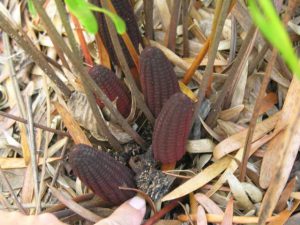
Male cones (strobilus) of coontie are thinner and shorter than female cones. Photo credit: Dan Culbert, UF IFAS
Another interesting feature of the coontie is its seed cones. These are large reddish orange cones that resemble magnolia seedpods. Both sexes of plant produce them in clusters ranging from one to five of the 2-7” long cones. Cones from the male produce pollen, while females produce seeds. If you are interested in attracting wildlife to your yard, the coontie provides good low-growing cover for birds and small mammals. It is also the preferred food for the caterpillar of the rare Atala butterfly. Members of the Timucuan and Calusa tribes ground up the starchy root of the coontie as a flour. However, the root contains a toxin and if it is not removed first, ingestion could result in severe abdominal pain and vomiting. From the late 1880’s through World War I, a large starch industry existed in Florida, producing flour from the coontie root.
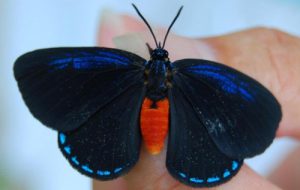
Adult female atala butterfly, showing royal blue streak on forewings. Photo credit: Sandy Koi, University of Florida
At home in drier soil conditions like oak hammocks and pinelands in north central Florida, these plants can also adapt to a variety of soil pH types. Coonties are drought, cold, and salt tolerant, thus a great landscape choice for coastal landscapes near the Gulf or a bay. The plants are very long-lived and adaptable. In fact, the book Florida’s Best Native Landscape Plants notes it is “Very hardy and easy to care for. Will grow well in any part of Florida, even outside its normal range. An exceptional replacement for the closely related, often used, but non-native sago palm.” In other words, this is an ideal landscape plant that should be used more throughout Florida.



















